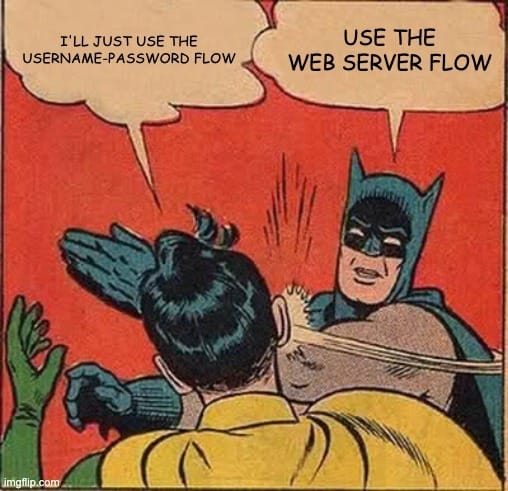- SalesforceChaCha
- Posts
- 💃 The Flow Showdown🕺
💃 The Flow Showdown🕺
Choosing OAuth wisely in Salesforce
Good morning, Salesforce Nerds! How comfy are you with OAuth?
At its core … it’s actually pretty simple: you want to use someone else’s data without asking for their password. 🤔
Instead of trading secrets in the alley, OAuth hands you a token. A temporary backstage pass.
Salesforce, like any respectable platform, speaks fluent OAuth 2.0. 🗣️
But the magic isn’t just the protocol; it’s how Salesforce bends it into Connected Apps, scopes, and tokens that keep your org secure without slowing down integrations.
The important distinction: OAuth is not authentication (proving who you are). ❌
It’s authorization (what you’re allowed to do). ✅
With Salesforce, OAuth is the backbone of every secure handshake. From Marketing Cloud sending emails to a third-party mobile app pulling opportunities.
Let’s break it down. 👇️

TABLE OF CONTENTS
💃 The Flow Showdown🕺
TOKENS, SCOPES, AND LIFELINES
ANATOMY OF THE OAUTH DANCE
When Salesforce plays OAuth, three characters hit the stage:
🎟️ Access Token – short-lived, used to access Salesforce APIs.
🔄 Refresh Token – longer-lived, used to grab a fresh access token without bugging the user again.
🔭 Scope – the “rules of engagement.” Want full API access? Great. Just don’t ask for more scope than you need. Principle of least privilege isn’t just theory — it’s your audit log’s best friend.
Connected Apps in Salesforce orchestrate this dance.
They define which flows are available, how tokens are issued, and what policies (IP ranges, session limits, PINs for mobile apps) keep them under control. 🎛️
And yes, monitoring matters.
Login history, event monitoring, and connected app usage reports give you a pulse on who’s asking for what … and whether they should.
THE ENTERPRISE CROWD-PLEASER
WEB SERVER FLOW WINS
The Web Server Flow is the heavy hitter for server-to-server integrations where you can keep a client secret safe. 💪
It’s the most common OAuth flow in Salesforce because it balances security with flexibility.
Here’s the rhythm: 🎼
User tries to access Salesforce via a client app.
Salesforce shows a login + consent screen.
After authentication, Salesforce returns an authorization code.
The client app trades that code for an access token (and refresh token, if configured).
Why it shines: 🌟
Tokens stay server-side, not exposed to browsers.
Refresh tokens mean fewer “login again” prompts.
Works beautifully for web apps, middleware, and integration hubs.
If you’re building integrations with MuleSoft, AWS Lambda, or any server you control, Web Server Flow should be your default choice. 💯
SILENT, SWIFT, NO PASSWORDS
JWT FLOW: TOKEN NINJA
The JWT Bearer Flow is the introvert of OAuth. 🤫
No user interaction. No passwords. Just a signed JWT (JSON Web Token) that proves your app’s identity to Salesforce.
Perfect for:
Scheduled jobs
Server-to-server integrations
CI/CD pipelines
Why architects love it: 💓
No need to store refresh tokens.
Authentication is handled by signed certificates — stronger and easier to rotate.
Works great when a human isn’t around to click “Allow.”
Think of JWT Flow as the API’s backstage pass. 🎫
The app shows Salesforce a tamper-proof note signed with a private key, and Salesforce says, “Yep, you’re on the list.” ✔️
CONVENIENT, BUT A LITTLE RISKY
USERNAME-PASSWORD FLOW: HANDLE WITH CARE
The Username-Password Flow is what it sounds like: send Salesforce a username, password, and client credentials, get back a token. 😨
Simple, but dangerous if misused. ⚡️
Where it fits:
Trusted, internal scripts
Legacy integrations you’re modernizing
Temporary bridges until you migrate to JWT
The big caveats: ✍️
You’re storing credentials. Which can be leaked.
No refresh tokens, so sessions must be managed carefully.
Salesforce limits this flow for good reason.
Treat it like a power tool: useful in a pinch, but don’t hand it out freely. 🔩
If you catch yourself deploying it outside of a secured internal job, take a step back.
There’s almost always a safer option. 👈️
OTHER FLOWS DESERVE A WAVE
HONORABLE MENTIONS & WRAP-UP
Salesforce offers more flavors than the big three. 💥
Here’s the quick roll call:
User-Agent Flow – lightweight for mobile or single-page apps, but tokens live in the browser.
Device Flow – great for smart TVs or kiosks with no keyboard.
SAML Bearer Assertion Flow – blends SAML with OAuth for SSO-heavy orgs.
Refresh Token Flow – technically not a login flow, but your safety net for long-lived sessions.
The point is not to memorize them all, but to choose wisely. 🧠
Each flow solves a different problem, and using the wrong one is like bringing a butter knife to a fencing match. Yeah, it’s technically a blade, but you’ll regret it. 🤺
The takeaway: Salesforce OAuth flows aren’t just academic.
They shape the security, scalability, and user experience of your org’s integrations. 🔒️
Pick the right flow, minimize scopes, monitor usage, and remember: OAuth is your friend, but only if you treat it with respect. 🔥
SOUL FOOD
Today’s Principle
"Effective cybersecurity is not a product, but a process."
and now....Salesforce Memes



What did you think about today's newsletter? |